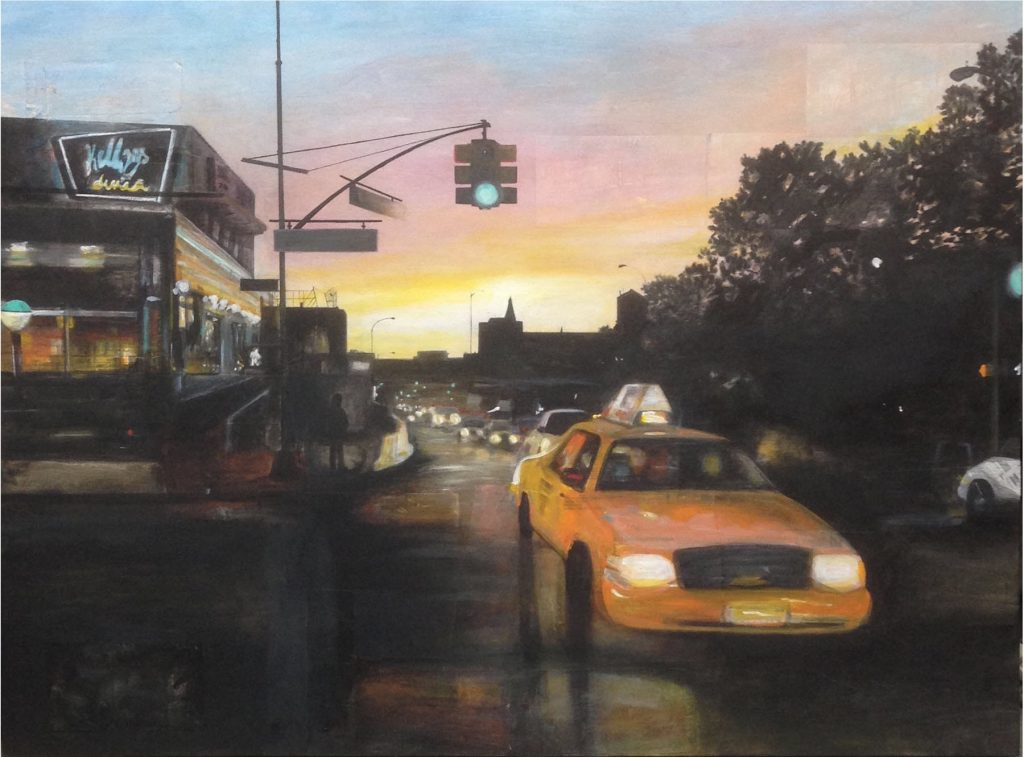The majority of my painting practice is focused on Q U O T A , a series that captures the many sides of New York City. Each work centers on a collage of NYC parking tickets, collected from the ground after being discarded by their recipients, or generously donated by friends. The origin story of Q U O T A follows.

The accumulation of these paper violations began when I was a student at the School of Visual Arts (at the start of R. Giuliani’s years as mayor) and has increased rapidly since. I hoarded all of the tickets I came across for almost a decade before being ready to use them in multimedia paintings and drawings. They are often ripped, waterlogged, scuffed, and sometimes scrawled with angry messages. In these conditions, the tickets are collaged onto the canvas to form the backbone of each painting, with the chosen composition on top. The barcodes and lines peek out in places creating structure, texture, or giving a pop of color.
Essential to the creation of Q U O T A is photography. It is a certain type of street scene or sun movement that catches my attention and later becomes a reference in the studio. Compositions are built to convey visually busy scenes of the city as well as the rare serene moments NYC manages to provide.
Q U O T A insinuates a commentary that while NYC has been renovated into a new and luxurious place over the past two decades, much of the change has been funded by ever-rising fines paid by the citizens and businesses that reside here.
Q U O T A also serves as historical documentation of certain places and patterns that have dematerialized in the same name of progress.
Click to browse the Q U O T A galleries
THE STATEMENT
They call it productivity goals, we call it quotas, and it’s a very stressful situation.
— D. Bailey, a Brooklyn union official with the Patrolmen’s Benevolent Association
In the mid-1990’s Rudolf Giuliani took his seat at the head of New York City very seriously, armed with a contentious plan to clean up the streets. This angered and confused many because it brought into question the use of public spaces. Beloved aspects of the landscape were suddenly considered a threat to the ‘quality of life’ and people began to get ticketed for all manner of outrageous “lawbreaking”. Street vendors, artists, musicians were first to be cleared from the curb, all fines were doubled and summonses were dealt out for unheard of offenses like “feeding the birds” and “flying a kite in a park.”
Police officers should be rewarded for deterring crime, not for writing twenty parking, five movers and five quality of lifers.
— A. Miranda, executive chairman of the National Latino Officers Association
Newspapers encouraged people to submit in their unjust ticketing stories for publication, and officers spoke out about the dangers of a quota system. The PBA went so far as to take out ad space reminding people “Don’t Blame the Cop” for heightened fines and unheard of infractions and urged to people to send letters to the mayor’s office in protest of the unspoken quota creating pressure among law enforcers to write daily tickets.
The NYPD has become a summons machine generating millions of dollars to close the city’s budget gap while eroding the relationship between police and the communities they serve.
– PBA president P. Lynch speaks about a quota system
As an artist, saving the iconic pieces of paper found strewn about the streets was a way to document a time of change, which was only just beginning. It wasn’t until two mayors, and almost a decade of collecting, that Orianne worked her first found ticket into a canvas, finally putting them to use. Bloomberg was well established in office, continuing to raise the standards and costs of living. Aggressive ticketing continued to mount and fill the coffers of the city not only from moving and quality of life violations but with building and environmental agencies contributing to the blitz.
Don’t blame me, blame Bloomberg!
– NYC cop after ticketing someone for improper use of a milkcrate
In early works, the found objects are carefully and chaotically laid onto abstract canvases, with a clear and forward role, meant to exemplify each ticket. As the series progresses, the summonses become the foundation of representational urban landscapes. The relentless tickets creating the infrastructure of each scenic painting, helping to portray the subjects within and the subjects of New York City, itself. Often times landscapes are recorded just before the scene is altered by demolition, redesign and/or reconstruction. The color and markings of each ticket, re-appropriated as a form of art, lend a depth to the work. Gritty shadows and whitewashed light vie in the street scenes, mixed with a little bit of protest.
*Tickets are only collected from the ground, never taken off a car, unless willingly donated by the owner. Thanks (and sorry) to all the ticket donors who have supported this series.
– Artist O. Cosentino on acquiring parking tickets for her paintings